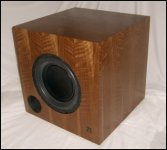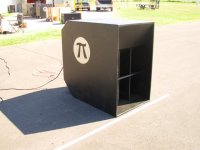Hey all, I didnt see anything about this when I did a search.
Is there any style of sub that is better/easier to integrate to your mains than any others?
I like the idea of tapped horns because they can have such awsome output for the cost of a single driver. However, I have also talked to a couple guys that say that they are also a bit more difficult to integrate well with your mains because of their more limited bandwidth....
Because of this I was thinking about going with a ported sub like the "Martysub" on AVS or maybe going with some sealed subs...
I like the higher output of a couple martysubs but I have also never had a system that goes down into the low teens which could be fun....
But I want the subs to integrate really well to the mains which I am planning to build...SEOS15 w/ JBL 2226H...
Is there any style of sub that is better/easier to integrate to your mains than any others?
I like the idea of tapped horns because they can have such awsome output for the cost of a single driver. However, I have also talked to a couple guys that say that they are also a bit more difficult to integrate well with your mains because of their more limited bandwidth....
Because of this I was thinking about going with a ported sub like the "Martysub" on AVS or maybe going with some sealed subs...
I like the higher output of a couple martysubs but I have also never had a system that goes down into the low teens which could be fun....
But I want the subs to integrate really well to the mains which I am planning to build...SEOS15 w/ JBL 2226H...
Integrating a TH (or any subwoofer where the main output originates from the end of a long horn or vent) can be a bit difficult. Fortunately if you have any sort of modern receiver with decent DSP built in, it can be a non-issue.
Current thinking for subwoofer duty is to use multiple small subwoofers around the room. There are a number of adjectives that can be applied to the Martysub - small ain't one of them .
.
Really, you've basically got to outline your needs and your environment, and perhaps someone can help you choose the best subwoofer solution to fit them.
In my case, here's what I plan to do for my next subwoofer upgrade - two small 12" vented subwoofers, disguised as tables, mounted on either side of the couch in my living/HT room. Great WAF, easy to build, they will produce all the output I'll ever need (for now, LOL) and I already have the drivers at hand, so it fits my needs .
.
Current thinking for subwoofer duty is to use multiple small subwoofers around the room. There are a number of adjectives that can be applied to the Martysub - small ain't one of them
Really, you've basically got to outline your needs and your environment, and perhaps someone can help you choose the best subwoofer solution to fit them.
In my case, here's what I plan to do for my next subwoofer upgrade - two small 12" vented subwoofers, disguised as tables, mounted on either side of the couch in my living/HT room. Great WAF, easy to build, they will produce all the output I'll ever need (for now, LOL) and I already have the drivers at hand, so it fits my needs
Wayne Parham has the Lab sub (1x driver) or the push-pull horn (2x Lab drivers) to work with his speaker kits that include the JBL 2226H in the 4Pi reflex and 7Pi corner-horn. You can get a few of them. Buy the 12 Pi hornsub in kit form ($270.00) or the complete speaker ($3200.00) 
Specifications: 30-100Hz, 108dB/2.83v/1M, 1600 watts RMS, 138dB/1M maxiumum output. 150dB max output in groups of four.
Specifications: 30-100Hz, 108dB/2.83v/1M, 1600 watts RMS, 138dB/1M maxiumum output. 150dB max output in groups of four.
The three π subwoofer uses a 12" woofer in a bass-reflex cabinet tuned to 20Hz.
The 12 π is a basshorn subwoofer using two 12" woofers with external heat sinks and push-pull drive.
Pi Speakers - Product Line and Driver Complements
Attachments
Hey guys, sorry for the late reply...I am out of work at the moment so the majority of my time has been spent looking for work.
Brian Steele,
I understand what you are saying but someone I was talking to who is using the top of the line Datasat processor was telling me that he was having issues with integration...So I wonder how well something like a Yamaha, Pioneer, or Anthem MRX can do it...
Wayne makes some good stuff. Since this is home theater application for myself I really want something that can atleast get down to 20hz. So that rules out the one horn.
I understand that the current trend is to have smaller subs around the room to smooth out the response and help eliminate the nulls to go along with Geddes subwoofer theory. However I dont think I will ever get the wife to allow more than two subs flanking the TV stand....
Brian Steele,
I understand what you are saying but someone I was talking to who is using the top of the line Datasat processor was telling me that he was having issues with integration...So I wonder how well something like a Yamaha, Pioneer, or Anthem MRX can do it...
Wayne makes some good stuff. Since this is home theater application for myself I really want something that can atleast get down to 20hz. So that rules out the one horn.
I understand that the current trend is to have smaller subs around the room to smooth out the response and help eliminate the nulls to go along with Geddes subwoofer theory. However I dont think I will ever get the wife to allow more than two subs flanking the TV stand....
http://www.parts-express.com/morel-ultimate-uw-1258-12-subwoofer--297-132
2x of these have a good potential in a 90L sealed each (smaller with EQ).
It does low twenties (sealed, 30Hz@-5dB) if that's what you are looking for.
For infrasound you will have to make BR (+drivers) enclosures.
Just saying, to have some good integration and LF extension with the 2226H roll in the 50's-100Hz I would go BR with adequate drivers for infrasound.
2x of these have a good potential in a 90L sealed each (smaller with EQ).
It does low twenties (sealed, 30Hz@-5dB) if that's what you are looking for.
For infrasound you will have to make BR (+drivers) enclosures.
Just saying, to have some good integration and LF extension with the 2226H roll in the 50's-100Hz I would go BR with adequate drivers for infrasound.
Last edited:
Thanks guys,
I'm big into both music and movies so I really want to get to atleast a good solid 20hz. I don't listen at deafening levels though so I think I should be fine with a pair of sealed subs probably.
I know all the rage right now but unless I build them into the attic or something along those lines I dont think it will really be worth the extra effort for me.
If anything I may do a slightly larger ported sub tuned into the mid to high teens if I really feel like a need the extra output.
I'm big into both music and movies so I really want to get to atleast a good solid 20hz. I don't listen at deafening levels though so I think I should be fine with a pair of sealed subs probably.
I know all the rage right now but unless I build them into the attic or something along those lines I dont think it will really be worth the extra effort for me.
If anything I may do a slightly larger ported sub tuned into the mid to high teens if I really feel like a need the extra output.
Any kind of bandpass sub is going to be more difficult to integrate. A large part in getting the sub sounding right is getting the crossover to the main speakers right, this is very difficult with a bandpass sub.
Why would it be more difficult with a bandpass sub?
I understand what you are saying but someone I was talking to who is using the top of the line Datasat processor was telling me that he was having issues with integration.
This suggests that his subwoofer is likely poorly located. If that is the case, the results can't be cleared up with DSP.
You know you're off to a bad start if you build a sub with a chosen location in mind, without finding out (by measurement or otherwise) if that location is the best spot to put the subwoofer.
You mean -10dB 20Hz?I'm big into both music and movies so I really want to get to atleast a good solid 20hz.
To have ~20Hz sealed it's only possible with equalization (Linkwitz Transform) as I know it.
It would take you a price-no-object (and space) to have a non EQ speaker to do -1 or -2 dB@20Hz with a HT AE-IB15 driver to make a ruler flat sealed speaker to the low frequencies.
Why would it be more difficult with a bandpass sub?
Because you have to work around the low pass filter inherent in the bandpass sub. Your main speakers might not reach down that far, or too far, and room placement might mean you need to be able to make further adjustment.
Because you have to work around the low pass filter inherent in the bandpass sub. Your main speakers might not reach down that far, or too far, and room placement might mean you need to be able to make further adjustment.
If you've run into an issue where the mains don't reach down as far as they need to, that simply means you've chosen an incorrect alignment for the bandpass subwoofer - one that is not a good match for your main speakers.
Room placement affects all subs, not just bandpass ones.
- Status
- This old topic is closed. If you want to reopen this topic, contact a moderator using the "Report Post" button.
- Home
- Loudspeakers
- Subwoofers
- Different styles of subs integrate better to the mains than others?

